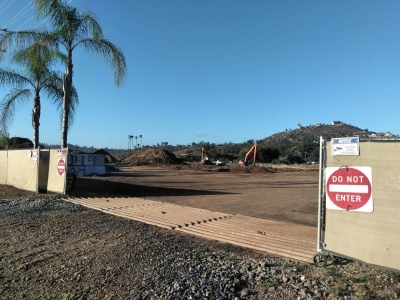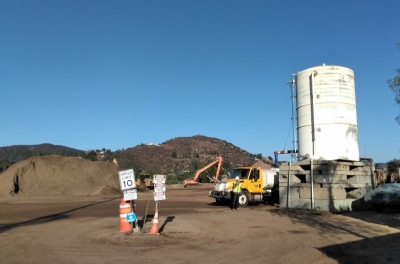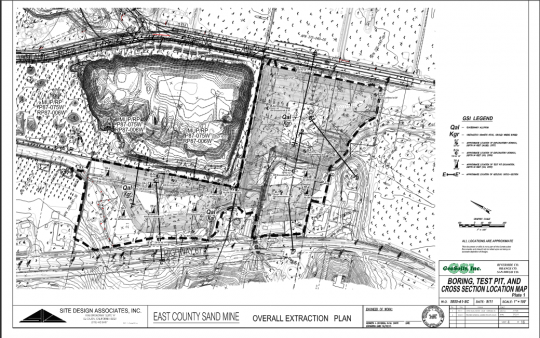 Lakeside planning group postpones action until Nov. 20 on proposal to deepen East County Sand Mine in Morena Valley to 80 feet
Lakeside planning group postpones action until Nov. 20 on proposal to deepen East County Sand Mine in Morena Valley to 80 feet
By Ana Nita, East County Magazine
October 23, 2019 (Lakeside) – Early in the morning on October 1st, dozens of trucks and heavy machinery traveled through in all directions on the job for the many industrial sites located (some would say “dumped” here with minimal or no county oversight) in this town.
Impacts of sand mines felt in Lakeside
Traffic at major intersections in Lakeside was jammed as usual. There were long waiting lines on Highway 67 in both directions, delaying anxious drivers at stoplights and backing up waiting commuters on side roads. The intersection of Mapleview and Ashwood streets posed hazards for hurried parents and their kids dropped off at El Capitan High School, with congested traffic continuing up the road at Mapleview Street and Highway 67, as well as Ashwood and Willow Rd. Turning left on Willow Rd. up to Moreno Ave., brought the same traffic scenario into sight. Driving back on Mapleview St. and going up on Lake Jennings Park Road to the I-8 east and west ramps was another hazardous experience on a two-lane street.
This is Lakeside, a town designed to remain mostly rural to preserve a predominantly country life style and equestrian traditions. The unincorporated town is in fact devoured by decades of deregulations that made room for opportunistic industries, especially sand mines that conquered the land in the 50s and 60s when there was no need for permits and reclamation plans.
Down the road on Moreno Ave. close to Vigilante Rd., there are two sand mines side by side with opposite histories. One is Enniss Inc., part of the old comers that started extraction before the Surface Mining and Reclamation Act of 1975 (SMARA) was implemented. Therefore, Enniss Inc. does not have a prescribed timeline to complete a reclamation plan according to SMARA.
Hunter McDonald, who oversees the permitting process for the East County Sand Mine next door owned by Bob Turner, said of the mines, “Some continue to operate today, however some are currently non-operational due to economic considerations. Once economic conditions become favorable to continue mining at those non-operational sites, reclamation efforts will then begin concurrent with mining.”
 McDonald clarified that these mines are inspected yearly in compliance with SMARA regulations. Lakeside did gather to protest Enniss Inc. excavations unsuccessfully and both Lakeside Community Planning Group (LCPG), a local gathering of elected volunteers with an advisory role, and the County voted in favor.
McDonald clarified that these mines are inspected yearly in compliance with SMARA regulations. Lakeside did gather to protest Enniss Inc. excavations unsuccessfully and both Lakeside Community Planning Group (LCPG), a local gathering of elected volunteers with an advisory role, and the County voted in favor.
A different story is being written about another sand mine across the hill from Enniss and Turner’s sand mines, in El Monte Valley.
Here, the current owner of the land, Bill Adams, escaped SMARA all together when he applied to build a golf course, but reportedly engaged in unauthorized excavations for a sand mine two decades ago. Gig Conaughton with the County Communication Office said on October 18, “When the County approved the Major Use Permit to build the El Capitan Golf Course in February 2000, there was no condition requiring a reclamation project.”
Consequently, Adams abandoned the land in 2005 with deep craters in the land, decimating the valley only to return a decade later to buy the land and apply for a sand mining permit. This project gathered a record number of local residents to protest. LCPG voted yes on this sand mine in the past, only to change its vote last year under pressure from the residents.
East County Sand Mine, new addition in Moreno Valley
Next door from Enniss, Inc., are the open gates to a new mining operation owned by benefactor and businessman Bob Turner. His mine was approved two years ago after a decade of back and forth with the county for permitting and environmental reviews. Turner’s sand mine encountered very little opposition from the residents, although the extraction was approved down to the water table at 25 ft. Concerns raised were similar to those voiced over other sand mines in the vicinity: pollution, traffic, the environment, the impact on the equestrian neighborhood, but especially about depleting the aquifer to operate the mine and fears that it might dry up people’s wells.
Across the street, plus up and down Moreno Ave. near these two mines and all around this zip code are mostly horse ranches and the typical countryside imagery of generous acreages, white fences, red-shouldered hawks and corals.
The two distinct worlds are often colliding and so far, one side has kept winning – the industrialists, unanimously backed by San Diego County and LCPG for the majority of projects so far. Turner had his victory in 2017 when LCPG and San Diego County Planning Commission approved a modified version of his initial request. Turner wanted to extract 1,175,000 cubic yards to a depth of 80 feet for 20 years. He was allowed to dig down to 25 feet, the same depth as the water table, and extract 647,000 cubic yards per year for 15 years.
In August of this year, Turner submitted a request to have his initial application restored, so he could dig 80 feet deep and extract over 1,2 million cubic yards of sand.
Consequently, Lakeside’s planning group included Turners’s application on the agenda for the public meeting on October 2nd to discuss and possibly vote on the project. LCPG labeled the project as a “sand mining expansion,” which proved to be inaccurate and created great confusion among local residents and also the board members.
CEQA or no CEQA?
Moreover, during the LCPG meeting on October 2nd, there was great confusion on all sides of the aisle with some residents believing this is not an active sand mine already approved, while others claiming it has to start all over with a new California Environmental Quality Act (CEQA) review.
In fact, the project already went through a full CEQA review under the original terms including 80 feet of depth and double the excavation volume for 20 years. Ultimately, the County approved it under certain limitations regarding the depth and the volume to be excavated, which reduced the total duration to 15 years. Right now, Turner wants the county to reconsider the project in its original form already reviewed under CEQA.
According to Hunter McDonald, Land Use/Environmental Planner with the County of San Diego and project manager for this application, the next step in the process “would be continuing to work with the applicant to resolve identified issues and determined potential impacts as a result of the proposed modification.”
Answering the community concerns about the aquifer, McDonald pointed out, “The project would not increase the groundwater use beyond the approved 32.6-acre feet per year limit, and would reclaim the site to the same finished surface design as approved in the original Reclamation Plan. If necessary, water use beyond the approved 32.6-acre feet per year groundwater limit would be provided by the Lakeside Water District as indicated by the completed Water Availability Form.”
But would the process start all over, with a new CEQA? After repeated requests for information, the County finalized the answer. McDonald said, “Yes, the process has started over again with this Modification.” The County is therefore reviewing a Major Use Permit Modification under CEQA. McDonald added, “However, please know that we consider this a brand new project application that includes analysis under CEQA, determining environmental impacts, public hearing, etc.” That means the County has to yet determine the appropriate CEQA environmental document for the project, according to McDonald.
Under SMARA, Turner is required to cover a Financial Assurance Mechanism (FAM) that fluctuates every year and is now set at $200,000, a sum determined by the area that is impacted by his sand mine in Moreno Valley.
Next, the application will be reviewed and voted on by LCPG (advisory vote only). Then it will be up for vote with the County’s Planning Commission and if appealed, it will go to the Board of Supervisors.
What does it look like?
A day before the LCPG meeting at the beginning of October, Turner’s sand mine had the gates wide open on Moreno Ave, offering an unobstructed view inside the operation. A water truck drove in circles wetting the ground, then stopped for a refill at the water tower erected on top of the property’s private well. “Mike” (who requested not to have his last name published), introduced himself as the “superintendent for the project” and said Turner is not applying for an expansion. “The only thing we are trying to do is go back to our original permit, which allows us to take this to full depth,” he said.
 Mike initially denied the extraction is affecting the aquifer and then reconsidered. “Oh yes, yes, you have the water table all the way around here. Actually, during the wintertime it was down about 18 feet. Now the water table is about 22-24 feet.” The superintendent said the ground is watered “any time is getting dusty. It depends; if it’s moist, we don’t have to worry about it. As we get into the heat of the day, we are doing it more often.” How much water is consumed every day to keep the sand wet? Mike said, “Ten to 12 tons of water every day.”
Mike initially denied the extraction is affecting the aquifer and then reconsidered. “Oh yes, yes, you have the water table all the way around here. Actually, during the wintertime it was down about 18 feet. Now the water table is about 22-24 feet.” The superintendent said the ground is watered “any time is getting dusty. It depends; if it’s moist, we don’t have to worry about it. As we get into the heat of the day, we are doing it more often.” How much water is consumed every day to keep the sand wet? Mike said, “Ten to 12 tons of water every day.”
Weighing in ton he neighbors’ concerns about traffic and pollution, Mike said, “It’s not that bad. We’ve been here for over a year and we haven’t had any complaints as far as entrance and exiting.”
Pros and cons
Next day at the LCPG public meeting with Turner’s sand mine on the agenda and 40 residents in attendance, Billi-Jo Swanson, who lives across the street from Turner’s mine, said, “I am still opposing it now because of the traffic, noise, dust and a promise two years ago that there would be no lights at night and there are. They go right through my bedroom window.” Swanson added, “My well is at 70 feet deep, so that means they are going 10 feet deeper than my well – what’s that going to do to my water?” Swanson concluded, “I hope karma prevails.”
Justin Kahler said he grew up in Lakeside in the ‘80s and ‘90s when “sand mines were everywhere. That’s why old school Lakesiders call the river bottom the “sand pits.”” Kahler pointed out sand mining is not a new local trend, but “It’s almost part of our heritage. The reality is that 99% of the people won’t be able to tell the difference between what was approved previously and what they want to expand once the mine gets started.” Kahler confessed, “The mine is going into a pretty industrialized zone, so I don’t really feel like it would have very much impact on anything of importance.”
Debra Montgomery, former secretary on LCPG at the time Turner’s sand mine was approved, took the microphone to oppose it again, underlining the water issue: “ I just had my well go out and had to do a new well to bring water at 60 feet. I don’t think it’s good to go deeper just because he has a hole in there. He’s got lots of other areas to mine before he has to go deeper.” Montgomery said going deeper would waste the groundwater. “I am not for it,” she stated.
Moreno Valley resident Steven Murray said, “I do find the lights and the noise to be offensive so far in this project. If you double the number of cubic yards and extend the project by one fourth, it would increase the traffic. I’d like somebody to do the math.”
Carrying a banner that read, “Lakeside deserves better,” local resident Dana Ortega demanded an answer from the planning group: “Why did you even approve this two years ago?” Ortega claimed, “Lakeside does not want to be a gravel pit.”
Another participant at the meeting fought back the protesters who claimed Turner does not live in Lakeside, saying, “Turner is a resident. So I wish people would be a little kinder, instead of being rude.” East County Sand, LLC is listing La Mesa as the current address on the MUP application.
Kenneth J. Discenza, the project engineer for East County Sand, LLC, claimed an extended sand mine is better than a limited sand mine. “The way it’s approved right now, they can open up as big a hole in the ground as they want because there is no limitation on how much ground water we can use. There’s no monitoring on the amount of water on a yearly basis that says you have to stop,” Discenza noted.
 In fact, the County approved a limit of 32.6-acre feet per year groundwater usage from the private well on the property. If more is needed, Lakeside Water District will provide the difference. Discenza added, “In this modification, you’re actually gonna have monitoring of the ground water and the ways we have to stay within that limit is to keep the size of the hole smaller. If we dig 80 feet, we don’t take all the water.”
In fact, the County approved a limit of 32.6-acre feet per year groundwater usage from the private well on the property. If more is needed, Lakeside Water District will provide the difference. Discenza added, “In this modification, you’re actually gonna have monitoring of the ground water and the ways we have to stay within that limit is to keep the size of the hole smaller. If we dig 80 feet, we don’t take all the water.”
According to the reclamation plan for this project, the aquifer will be resurfaced, creating a wetland on certain areas including the Slaughterhouse Creek, which will be entirely displaced as part of a flooding plan included in the MUP.
Discenza pointed out, “Sand is a resource everybody uses. I find it interesting that everybody in this room either walked here or drove a car. They walk out on concrete sidewalk or drove on a road that has sand in it.” He added, “All that sand comes from a local source.” Discenza said local sand has a smaller carbon imprint compared with imported sand (since transporting sand long distances uses fuel that contributes to greenhouse gas emissions).
Lakeside resident Jitka Parez attended every LRPC public meeting related to this project in order to oppose it. Parez pointed out, “This is a symptom of pushing the limits of a destructive industry and setting a precedent for the future sand mining throughout Lakeside.” Parez reminded the planning group, “This town is supposed to be not only zoned for sand mining, but it’s supposed to keep a rural character, so I am asking you to please maintain a balance.”
Ethical concerns
Checking back on the reasoning used by LCPG in 2017 to justify their unanimous vote of approval for Turner’s project, one of the arguments used by the group member Steve Robak was, “Bob is a good guy.” Robak is still on the LCPG and is also the District Director on the Lakeside Water District listed as a water provider for Turner’s sand mine. The County Communication Office’s response about this situation is still pending.
Turner himself was a member on the LCPG in 2016 (seat 15) before the same group approved his project. In 2017, current chairman Brian Sesko answered Swanson’s concerns about losing the well water: “Maybe it’s unfortunate for you and you’re going to be affected more than everybody else, but this is no different than me trying to bend off the fact that the State was telling me that my cows can’t fart, but that’s the reality we are dealing with.”
One town, two valleys, a bunch of sand mines - same story
Milton Cyphert was the LCPG chairman when the sand mine was approved and remains on the board as a member. Back in 2017, Cyphert said this sand mine “will bring businesses and revenue to our community because that land is now just a wide, dirt spot on the road.” On October 1st of this year there were three people visibly working on Turner’s sand mine. On October 2nd, Cyphert claimed, “This sand mine the way is currently approved in no way has anything to do with a foretelling of the El Monte Valley (sand mine); that’s a whole separate project and entirely different aspects.”
Disproving Cyphert’s statement is the Environmental Impact Report completed for Turner’s sand mine that includes almost identical issues with the ones raised by another proposed sand mine for El Monte Valley mentioned by Cyphert and strongly opposed by the community. El Monte Valley is across the hill from Moreno Valley along Willow Rd that connects them.
The EIR for Turner’s mine underlines concerns about the same endangered species living in close proximity in El Monte Valley (Least Bell’s Vireo is one of them), identical concerns about the underground water (same aquifer), traffic (same exits on Highway 67 and I-8), pollution (same type of industrial operation), and similar cumulative impact on the town’s rural character. El Monte Valley and Moreno Valley are both zoned for agricultural, rural and mining and heavily populated by ranchers and equestrians.
Moreover, the county is investing millions of dollars in the construction of a state-of-the-art equestrian park down the road from Turner’s sand mine, with the goal of turning Lakeside into an epicenter of equestrian activities and events for the entire Southern California region. Allowing more industrial projects in close proximity could jeopardize that goal, declared Swanson the day before the LCPG meeting. In other words, sand mining and horses do not mix.
Additionally, the LCPG voting record indicates an overwhelming majority of votes in favor of all the sand mining projects submitted for approval, including the one in El Monte Valley, with one exception last year in October, when under the pressure of over 500 residents in the room, the board was forced to vote “no.” This group has an advisory role only with the County of San Diego that holds the actual decisional power.
Several of the LCPG members were not familiar with this project, although the board approved it two years ago. Chairman Brian Sesko claimed the goal of this meeting was not to vote on it again, but to listen to the residents’ concerns. However, a voting form bearing the County stamp was on display, ready to be used.
Sesko postponed any decision until November 20th, when he scheduled the next public meeting, counting on the County representatives to attend and provide clarifying answers.









Recent comments